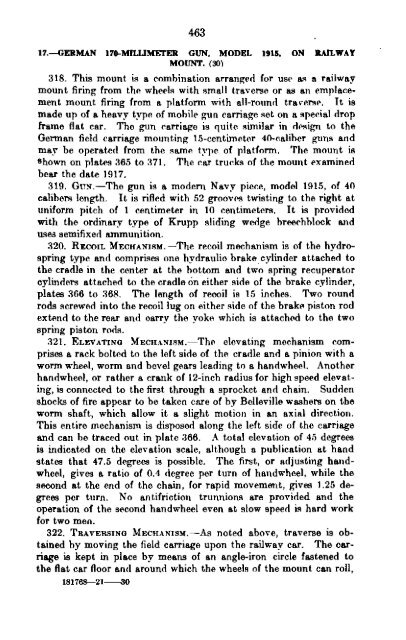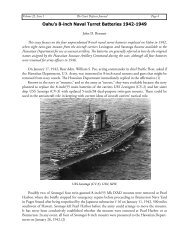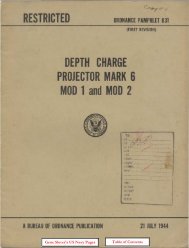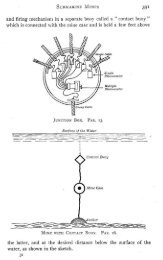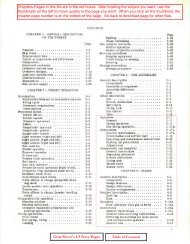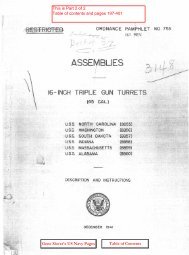...Railway artillery - Personal Page of GENE SLOVER
...Railway artillery - Personal Page of GENE SLOVER
...Railway artillery - Personal Page of GENE SLOVER
You also want an ePaper? Increase the reach of your titles
YUMPU automatically turns print PDFs into web optimized ePapers that Google loves.
463<br />
17.-GERMAN 170-MILUMETER GUN, MODEL 1915. ON RAILWAY<br />
MOUNT. (30)<br />
318. This mount is a combination arranged for use as a railway<br />
mount firing from the wheels with small traverse or as an emplacement<br />
mount firing from a platform with all-round traverse. It is<br />
made up <strong>of</strong> a heavy type <strong>of</strong> mobile gun carriage set on a special drop<br />
frame flat car. The gun carriage is quite similar in d('Sign to the<br />
German field carriage mounting 15-centimeter 40-caliber guns and<br />
may be operated from the same type <strong>of</strong> platform. The mount is<br />
Shown on plates 365 to 371. The car trucks <strong>of</strong> the mount ('xamined<br />
bear the date 1917.<br />
319. GUN.-The gun is a modem Navy piece, model 1915, <strong>of</strong> 40<br />
calibers length. It is rifled with 52 grooves twisting to the right at<br />
uniform pitch <strong>of</strong> 1 centimeter in 10 centimeters. It is provided<br />
with the ordinary type <strong>of</strong> Krupp sliding wedge breechblock and<br />
uses semifixed ammunition.<br />
320. RECOIL MECHANISM.-The recoil mechanism is <strong>of</strong> the hydrospring<br />
type and oomprises one hydraulio brake. cylinder attached to<br />
the cradle in the center at the bottom and two spring recuperator<br />
cylinders attached to the cradle on either side <strong>of</strong> the brake cylinder,<br />
plates 366 to 368. The length <strong>of</strong> reooil is 15 inches. Two round<br />
rods screwed into the recoil lug on either side <strong>of</strong> the brake piston rod<br />
extend to the rear and oarry the yoke which is attached to the two<br />
spring piston rods.<br />
321. ELEVATING MECHANIsM.-The elevating mechanism comprises<br />
a rack bolted to the left side <strong>of</strong> the cradle and a pinion with a<br />
worm wheel, worm and bevel gears leading to a handwheel. Another<br />
handwheel, or rather a crank <strong>of</strong> 12-inch radius for high speed elevating,<br />
is connected to the first through a sprocket and chain. Sudden<br />
shocks <strong>of</strong> fire appear to be taken care <strong>of</strong> by Belleville washers on the<br />
worm shaft, which allow it a slight motion in an axial direction.<br />
This entire mechanism is disposed along the left side <strong>of</strong> the carriage<br />
and can be traced out in plate 366. A total elevation <strong>of</strong> 45 degrees<br />
is indicated on the elevation scale, although a publication at hand<br />
states that 47.5 degrees is possible. The first, or adjusting handwheel,<br />
gives a ratio <strong>of</strong> 0.4 degree per turn <strong>of</strong> handwheel, while the<br />
second at the end <strong>of</strong> the chain, for rapid movement, gives 1.25 degrees<br />
per turn. No antifriction trunnions are provided and the<br />
operation <strong>of</strong> the second handwheel even at slow speed is hard work<br />
for two men.<br />
322. TRAVERSING MECHANlSM.-As noted above, traverse is obtained<br />
by moving the field carriage upon the railway car. The oarriage<br />
is kept in place by means <strong>of</strong> an angle-iron circle fastened to<br />
the flat car floor and around which the wheels <strong>of</strong> the mount can roll,<br />
181768--21----30<br />
Digitized by Coogle


